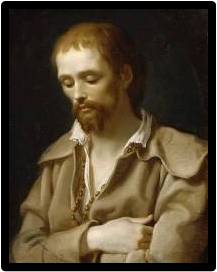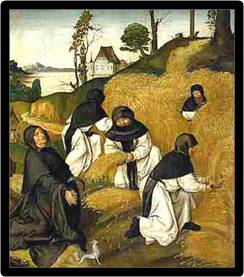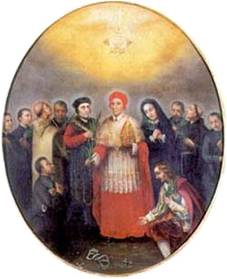APRIL 16 - ST. BENEDICT JOSEPH LABRE

St. Benedict was born at Amettes, Boulogne in France. This French saint led a most unusual life. He was one of fifteen children in a well-off middle class family. His father was a store owner and Benedict was taught by his uncle, a priest.
When the good priest died, Benedict tried to enter a monastery but they refused to take him in as he was too young. Then he managed to convince another order of monks to take him in. He loved the life of prayer and penance but soon Benedict became thin and frail.
They suggested that he return home and lead a good Christian life. He had no choice, he went home and slowly gained back his health. He prayed asking God to show him what he was to do with his life.
He soon felt he had the answer. He would become a pilgrim, a person on a holy journey of prayer and penance. As a pilgrim, he would travel to the famous shrines of Europe.
Benedict began his journey on foot. He visited one church after another. He wore a plain cloth robe, a crucifix over his heart and a rosary around his neck. He slept on the bare ground. The only food he had was what kind people gave him. If they gave him money, he gave it to the poor.
If he was given more food than he needed for the day, he would give the remainder to someone who needed it more than he did. He healed some of his homeless friends and even multiplied bread for them, when they had no food.
His “suitcase” was a sack. In it he carried his own Gospel, as well as medals and holy books to give to others. St. Benedict paid no attention to the beautiful sights in the cities he visited. His only interest was in the churches where Jesus dwelt in the Blessed Sacrament.
When St. Benedict knelt in front of the tabernacle, he became as still as a statue. His pale, tired face glowed. It was said he often floated in the air when he looked at Jesus’ Crown of Thorns and deeply felt His pain.
He would talk to Jesus and to the Blessed Mother. He would whisper, “Mary, O my Mother!” He was truly happy when he was keeping Jesus and Mother Mary company.
As the years passed, St. Benedict looked more and more like a beggar. He was ragged and dirty. He ate crusts of bread and potato peels. He never asked for anything that would make his life more comfortable. In some places, children threw stones at him and called him names.
People who didn’t know him tended to avoid him. But people who did know him both rich and poor came to him for advice and counsel.
He died in 1783 at the age of thirty-five. The fame of this poor holy man spread far and wide. His journey had ended. The pilgrimage was over and he would be with Jesus and Mary forever.



